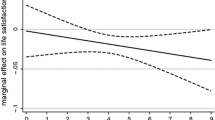Abstract
This paper addresses an important policy question: who gets the largest utility gain from income and does the tax system adequately reflect this? We address this question by using Australian panel data and taking life satisfaction as a proxy for utility, allowing us to identify the marginal utility of additional income for different groups of individuals. We find that optimal transfers consist of transfers from the old to the middle aged, and from the married to the unmarried. This optimal utilitarian welfare policy is then contrasted with information on who actually receives transfers and who pays for them in Australia, where we find that taxes are too high for some groups, like the young, and that they are too low for other groups, like the elderly. We believe that the methodology developed in this paper could be fruitfully applied to the issue of optimal taxation in other countries.

Similar content being viewed by others
Notes
The Australian Bureau of Statistics (2007) estimates the effects of government benefits and taxes on the distribution of income among private households in Australia in 2003–2004. The study excludes government taxes and expenditure that do not relate directly to households, such as government revenue from corporate taxes and government spending on defence. We include expenditures on amenities, like schooling, because they substitute for private payments.
References
Australian Bureau of Statistics. (2007). Government benefits, taxes and household income. Cat No 6537.0. Canberra: ABS.
Borjas, G. J. (2004). Labor economics (3rd ed.). New York: Mc-Graw Hill.
Carroll, N., Frijters, P., & Shields, M. A. (2009). Quantifying the costs of drought: New evidence from life satisfaction data. Journal of Population Economics, 22, 445–461.
Clark, A., Diener, E., Georgellis, Y., & Lucas, R. (2008a). Lags and leads in life satisfaction: A test of the baseline hypothesis. Economic Journal, 118, F222–F239.
Clark, A., Frijters, P., & Shields, M. A. (2008b). Relative income, happiness and utility: An explanation for the Easterlin Paradox and other puzzles. Journal of Economic Literature, 46, 95–144.
Di Tella, R., & MacCulloch, R. (2006). Some uses of happiness data in economics. Journal of Economic Perspectives, 20, 25–46.
Faulk, D., Martinez-Vazquez, J., & Wallace, S. (2007). Using human-capital theory to establish a potential-income tax. FinanzArchiv: Public Finance Analysis, 63(3), 415–435.
Ferrer-i-Carbonel, A., & Frijters, P. (2004). The effect of methodology on the determinants of happiness. Economic Journal, 114, 641–659.
Ferrer-i-Carbonell, A., & van Praag, B. M. S. (2002). The subjective costs of health losses due to chronic diseases. An alternative model for monetary appraisal. Health Economics, 11(8), 709–722.
Frey, B., Luechinger, S., & Stutzer, A. (2007). Calculating tragedy: Assessing the costs of terrorism. Journal of Economic Surveys, 21, 1–24.
Frey, B., Luechinger, S., & Stutzer, A. (2009). The life satisfaction approach to valuing public goods: The case of terrorism. Public Choice, 138, 317–345.
Frey, B., & Stutzer, A. (2002). What can economists learn from happiness research? Journal of Economic Literature, 40, 402–435.
Frijters, P., & Gregory, R. (2006). From golden age to golden age: Australia’s Great Leap forward. Economic Record, 82, 207–225.
Frijters, P., Haisken-DeNew, J., & Shields, M. A. (2004). Money does matter! Evidence from increasing real income and life satisfaction in East Germany following reunification. American Economic Review, 94, 730–740.
Gruber, J., & Saez, E. (2002). The elasticity of taxable income: Evidence and implications. Journal of Public Economics, 84, 1–32.
Hallam, A., & Weber, E. J. (2007). Labour taxes and work hours in Australia. Working Papers no. 07-09, University of Western Australia, Department of Economics.
Layard, R., Mayraz, G., & Nickell, S. (2008). The marginal utility of income. Journal of Public Economics, 92(8–9), 1846–1857.
Luechinger, S., Meier, S., & Stutzer, A. (2008). Bureaucratic rents and life satisfaction. Journal of Law, Economics and Organization, 24, 476–488.
Meier, S., & Stutzer, A. (2007). Is volunteering rewarding in itself? Economica, 75, 39–59.
Mirrlees, J. A. (1971). An exploration in the theory of optimum income taxation. Review of Economic Studies, 38(114), 175–208.
Plug, E. J. S., van Praag, B. M. S., & Hartog, J. (1999). If we knew ability, how would we tax individuals? Journal of Public Economics, 72(2), 183–211.
Prescott, E. C. (2004). Why do Americans work so much more than Europeans? Federal Reserve Bank of Minneapolis Quarterly Review, 28, 2–13.
Saez, E. (2001). Using elasticities to derive optimal income tax rates. Review of Economic Studies, 68, 205–229.
Stutzer, A., & Frey, B. (2008). Stress that doesn’t pay: The commuting paradox. Scandinavian Journal of Economics, 110, 339–366.
Tinbergen, J. (1970). Belasting op bekwaamheid [Tax on ability]. Intermediair, 30(6), 1–3.
Van Praag, B. M. S., & Baarsma, B. E. (2005). Using happiness surveys to value intangibles: The case of airport noise. Economic Journal, 115, 224–246.
Van Praag, B. M. S., & Frijters, P. (1999). The measurement of welfare and well-being; the Leyden approach. In D. Kahneman, E. Diener, & N. Schwarz (Eds.), Well-being: The foundations of hedonic psychology (pp. 413–432). New York: Russel Sage Foundation. (Handbook).
Watson, N., & Wooden, M. (2004). The HILDA survey four years on. Australian Economic Review, 37, 343–349.
Winkelmann, L., & Winkelmann, R. (1998). Why are the unemployed so unhappy? Evidence from panel data. Economica, 65, 1–17.
Acknowledgments
This paper uses unit record data from the Household, Income and Labour Dynamics in Australia (HILDA) survey. The HILDA project was initiated and is funded by the Australian Government Department of Families, Housing, Community Services and Indigenous Affairs (FaHCSIA) and is managed by the Melbourne Institute of Applied Economic and Social Research (MIAESR). The findings and views reported in this paper, however, are those of the author and should not be attributed to either FaHCSIA or the MIAESR.
Author information
Authors and Affiliations
Corresponding author
Rights and permissions
About this article
Cite this article
Frijters, P., Johnston, D.W. & Shields, M.A. The Optimality of Tax Transfers: What does Life Satisfaction Data Tell Us?. J Happiness Stud 13, 821–832 (2012). https://doi.org/10.1007/s10902-011-9293-3
Published:
Issue Date:
DOI: https://doi.org/10.1007/s10902-011-9293-3



